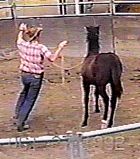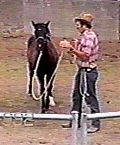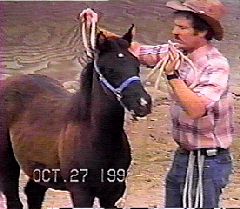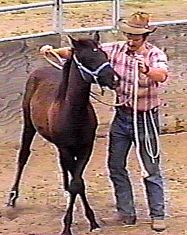|
In Part Three we discussed the basics of teaching the horse to back up.
In this part we will progress to lateral yields.
|
|
TEACHING THE HORSE TO YIELD
|
|
Yields are a very important part of ground schooling. A horse who will
yield is safer since he is less likely to crowd your space and if he does, you can get him off of you. Yields teach the horse to respond to pressure. They also assert your dominance in his native horse language.
|

|
|
While longeing the horse at a relaxed walk, I have now stepped slightly in front of the drive line with my control hand, but still am applying some energy behind the drive line with my active hand. At this point the horse is going to sense the pressure and tend to step away from me. I can then walk
toward the horse and he should yield away.
|

|
|
Here's what it looks like from the front view. The rope stays slack as I want the horse to be able to maneuver on his own away from me. If for some reason he were to panic, however, I could tighten my grip and step back one step which would draw his head slightly toward me and correspondingly his hind end would rotate away from me.
|
|
If the horse tends to squirt away from me, I can repeat the evolution but hold the halter end of the rope in my right hand to check his forward motion while creating a moving visual barrier by placing left hand up by his eye. With a really "stuck" horse, I can almost strike his eye with my left hand while tapping him on the neck with the rope strung between my two hands. As soon as he moves off, I'll release the pressure. This particular maneuver is a little awkward at first, but with some practice and by thoughtfully setting it up, you can execute it correctly. The biggest difficulty may be in your determining exactly where to stand so that you don't squirt the horse either forwards or backwards.
|

|
|
The ultimate objective here is for you to get the horse to respond to your space and energy and to maintain a proper distance from your space. He should also to learn to control his feet in the process. He should step across himself
with the moving foot passing in front of the stationary foot. If he crossed behind himself he could accidentally step on his own heel bulb which would be painful. We always want the horses to cross in front and this is one way in which you can control him during yields and teach him correct leg movements.
In the next part we will discuss teaching the horse to disengage.
|

|
Important Note: If you take on the project of
developing an untrained horse, everybody will want to give you advice.
Don't act on any advice, including the ideas offered in this site,
unless it makes sense to you and fits your individual situation. Your
abilities and the sensitivities of your horse(s) may differ from the
examples given. Be alert and rational with your actions so neither you nor
your horse will get hurt. This information is offered as illustrations of
what we do and the reader must apply common sense since he or she is solely
responsible for his or her actions.
Happy trails!
Press "Back" to return to the page that brought you here
KBR Horse Training Information, © 1997
Lamm's Kickin' Back Ranch and Willis & Sharon Lamm. All rights reserved. Duplication of any of
this material for commercial use is prohibited without express written permission.
This prohibition is not intended to extend to personal non-commercial use, including sharing
with others for safety and learning purposes, provided this copyright notice is
attached.
Email us to submit comments or
request reproduction permission.
|




